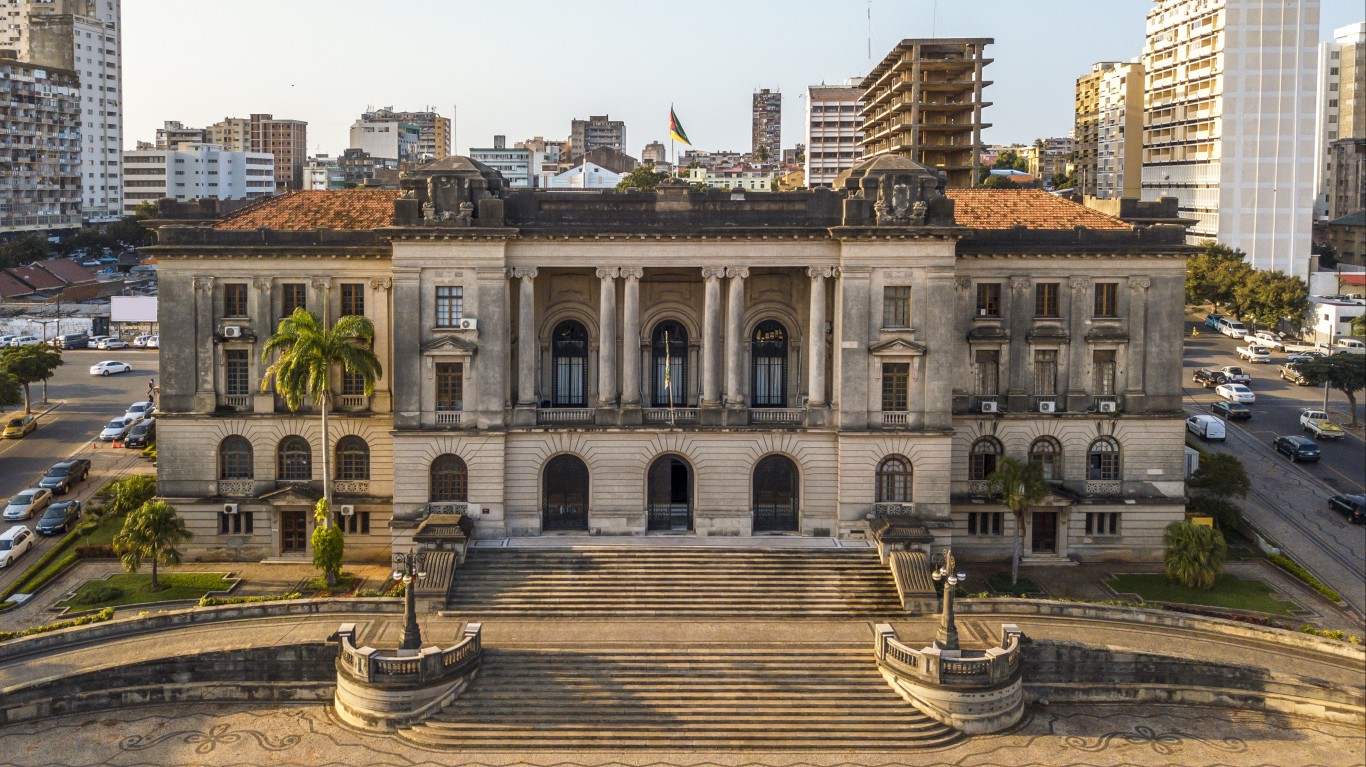Special Report
The 15 Countries Where Gov't Debt Is Larger Than the Entire Economy

Published:
Last Updated:

The amount of debt accumulated by the United States government has ballooned in the last 100 years – from an inflation-adjusted $409 billion in 1922 to $30.9 trillion 2022. The last time the federal government operated on a balanced budget was in fiscal 2001, under a funding plan put together by the Clinton administration. Every year since, government spending has outpaced revenue, often by a wide margin, further deepening the national debt.
In recent decades, the wars in Iraq and Afghanistan, the Great Recession, and the COVID-19 pandemic have all contributed to deficient spending in Washington D.C. Due to these and other factors, the national debt more than doubled between 2008 and 2022, and in 2019, for the first time since World War II, the U.S. joined the short list of countries where government debt exceeds gross domestic product (total annual economic output). (Here is a look at the U.S. presidents who oversaw the largest changes in the national debt.)
Using data from the World Bank, 24/7 Wall St. identified the 15 countries where the government debt is larger than the country’s GDP. Countries are ranked by their central government’s debt as a share of GDP in 2020, the most recent year of available data. 2021 GDP and GDP per capita figures are in current U.S. dollars. For each country, we also reviewed fiscal 2021 GDP and credit ratings from Moody’s, a global risk management firm.
The countries on this list span the world, from East Asia to the Americas, Europe, and Africa. The ratio of government debt to its GDP is important for several reasons. According to the World Bank, countries that carry a debt-to-GDP ratio of 77% or more for prolonged periods of time are at increased risk of an economic slowdown, though not all countries with high debt-to-GDP ratios are similar.
While some countries with a high debt-to-GDP ratio are at greater risk of defaulting on loan payments and fueling instability in financial markets, others are among the richest countries in the world and maintain strong credit ratings. Countries such as Mozambique or even Brazil, which have relatively low GDP per capita, are far different from countries like Iceland and Singapore that have relatively high GDP per capita. (Here is a look at the 25 richest countries in the world.)
In fact, five countries on this list, including the United States, are rated at either “prime” or “high grade” investment ratings despite prolonged high debt-to-GDP ratios. Meanwhile, Spain and Greece are still feeling the effect of the European debt crisis that followed the 2008 financial crisis, serving as a reminder for the troubles swelled debt can cause.
Exactly how long those ratings can stand without a meaningful reduction in government debt, especially among the poorer countries on the list, remains to be seen.
Click here to see the 15 countries where gov’t debt is larger than the entire economy.
15. Iceland
> Debt as a share of GDP: 100.0%
> GDP, 2021 (current US$): $25.6 billion
> GDP per capita, 2021: $68,728
> Moody’s credit rating: A2 (Upper medium grade)
[in-text-ad]

14. Brazil
> Debt as a share of GDP: 100.6%
> GDP, 2021 (current US$): $1.6 trillion
> GDP per capita, 2021: $7,507
> Moody’s credit rating: Ba2 (Non-investment grade speculative)

13. Mozambique
> Debt as a share of GDP: 102.9%
> GDP, 2021 (current US$): $15.8 billion
> GDP per capita, 2021: $492
> Moody’s credit rating: Caa2 (Extremely speculative)

12. Zambia
> Debt as a share of GDP: 103.7%
> GDP, 2021 (current US$): $22.1 billion
> GDP per capita, 2021: $1,137
> Moody’s credit rating: Ca (In default with little prospect for recovery)
[in-text-ad-2]

11. Croatia
> Debt as a share of GDP: 104.9%
> GDP, 2021 (current US$): $69.0 billion
> GDP per capita, 2021: $17,685
> Moody’s credit rating: Baa2 (Lower medium grade)

10. Jamaica
> Debt as a share of GDP: 106.3%
> GDP, 2021 (current US$): $14.7 billion
> GDP per capita, 2021: $5,184
> Moody’s credit rating: B2 (Highly speculative)
[in-text-ad]

9. Bhutan
> Debt as a share of GDP: 117.3%
> GDP, 2021 (current US$): $2.5 billion
> GDP per capita, 2021: $3,266
> Moody’s credit rating: N/A (N/A)

8. Belgium
> Debt as a share of GDP: 119.4%
> GDP, 2021 (current US$): $594.1 billion
> GDP per capita, 2021: $51,247
> Moody’s credit rating: Aa3 (High grade)

7. France
> Debt as a share of GDP: 123.0%
> GDP, 2021 (current US$): $3.0 trillion
> GDP per capita, 2021: $43,659
> Moody’s credit rating: Aa2 (High grade)
[in-text-ad-2]

6. United States
> Debt as a share of GDP: 126.4%
> GDP, 2021 (current US$): $23.3 trillion
> GDP per capita, 2021: $70,249
> Moody’s credit rating: Aaa (Prime)

5. Spain
> Debt as a share of GDP: 141.2%
> GDP, 2021 (current US$): $1.4 trillion
> GDP per capita, 2021: $30,104
> Moody’s credit rating: Baa1 (Lower medium grade)
[in-text-ad]

4. Singapore
> Debt as a share of GDP: 153.4%
> GDP, 2021 (current US$): $397.0 billion
> GDP per capita, 2021: $72,794
> Moody’s credit rating: Aaa (Prime)

3. United Kingdom
> Debt as a share of GDP: 195.4%
> GDP, 2021 (current US$): $3.1 trillion
> GDP per capita, 2021: $46,510
> Moody’s credit rating: Aa3 (High grade)

2. Japan
> Debt as a share of GDP: 216.3%
> GDP, 2021 (current US$): $4.9 trillion
> GDP per capita, 2021: $39,313
> Moody’s credit rating: A1 (Upper medium grade)
[in-text-ad-2]

1. Greece
> Debt as a share of GDP: 252.3%
> GDP, 2021 (current US$): $214.9 billion
> GDP per capita, 2021: $20,193
> Moody’s credit rating: Ba3 (Non-investment grade speculative)
Are you ahead, or behind on retirement? For families with more than $500,000 saved for retirement, finding a financial advisor who puts your interest first can be the difference, and today it’s easier than ever. SmartAsset’s free tool matches you with up to three fiduciary financial advisors who serve your area in minutes. Each advisor has been carefully vetted and must act in your best interests. Start your search now.
If you’ve saved and built a substantial nest egg for you and your family, don’t delay; get started right here and help your retirement dreams become a retirement reality.
Thank you for reading! Have some feedback for us?
Contact the 24/7 Wall St. editorial team.